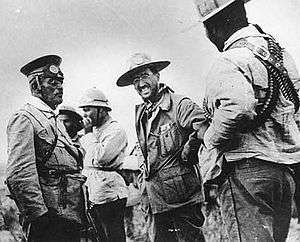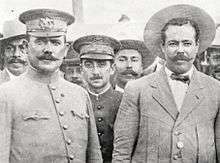Emilio Madero
General Emilio Madero González (8 August 1880 – 16 January 1962) was a Mexican soldier who participated in the Mexican Revolution, and the brother of Francisco I. Madero.
General Emilio Madero González | |
|---|---|
 Madero in 1912. Left to right: Victoriano Huerta, Emilio Madero, and Pancho Villa. | |
| Born | 8 August 1880 Parras de la Fuente, Coahuila |
| Died | 16 January 1962 (aged 81) Mexico City, Federal District |
| Battles/wars | Mexican Revolution |
| Spouse(s) | Mercedes Belden Gutiérrez[1] |
| Relations | Brothers: Ernesto Madero Francisco I. Madero Gustavo A. Madero Children: Pablo Emilio Madero |
Biography
Early life
Emilio Madero was born in Parras, Coahuila, on 8 August 1880, the sixth son of Francisco Madero Hernández and Mercedes González Treviño. He was the brother of Francisco I. Madero, the leader of the Mexican Revolution.[1]
Mexican Revolution
He participated in the Madero movement during the Mexican Revolution. In April 1911 he led the forces which conquered the Mexican state of Durango, capturing Mapimí, Lerdo, and Gómez Palacio. In May 1911 he led the assault on Torreón, which was a key location to seizing control of the surrounding area. However, when his Maderistas finally took the city on 15 May, they were joined by a local mob and massacred the city's Chinese residents. Madero finally managed to bring them under control, but not until 10 hours had passed and over 300 Chinese lay dead.[2] He had difficulty maintaining control of the area, though, and in June was forced to form a group of loyal men, who he paid $1.50 a day, to control rebellious former Maderistas.[3] He was then aligned to the División del Norte[4]:442, 462 in 1912 fighting Pascual Orozco under General Victoriano Huerta as a Colonel.[5] During this time he was instrumental in saving Pancho Villa from execution, arguing for his life with Huerta, who wanted him out of the way.[6]
Madero married Mercedes Belden Gutiérrez on 27 January 1913 in Monterrey, Nuevo León.[1][7] The couple had four children,[7] including Pablo Emilio Madero Belden,[8] who was inspired to go into politics on his father's account.[9]
Exile

Madero was in San Pedro, Coahuila, with Venustiano Carranza during La Decena Trágica in February 1913.[10][11] Following the death of his brother Francisco, it was reported that he had been shot and killed just north of Monterrey on 26 February; according to rumor he had been overtaken by General Trevino between Villaldama and Bustamante while leading a group of 35 to join a force of rebels in Laredo. The report was declared false the next day.[12][13][14] On 6 March, he was forced to flee Mexico with another brother, General Raúl Madero, and the two swore to avenge the President's death.[12]
He had returned to Mexico by August 1914, and was in Chihuahua with Pancho Villa.[15] In early 1915, Madero led 2,000 troops to capture Saltillo under the command of General Felipe Ángeles,[16] later participating in a cavalry charge on 8 January that resulted in the capture of 3,000 prisoners in Ramos Arizpe.[17] Following the appointment of Roque González Garza as President, Madero was made governor of Sinaloa.[18] Later that same year, however, on 12 October 1915, Emilio and Raúl refused to join Villa in waging guerrilla warfare.[4]:518[19] Madero was still abroad in 1918, and was living in San Antonio.[20]
By 1921 he had returned to Mexico, and was living on a farm in San Pedro. Madero and his family went into exile again in 1926. They spent a year in California and two in Texas before returning to Mexico in 1929.[21]
Later life
He was the leader of the Revolutionary Party of National Unification until 1940, when he was removed for calling the party "paralyzed" due to lack of communication with leader Juan Andreu Almazán.[22]
Madero died in Mexico City on 16 January 1962,[1] and was buried in the Panteón Francés de la Piedad.[23]
References
- "Emilio Madero González". Familia Madero (in Spanish). Archived from the original on 29 June 2013. Retrieved 7 January 2015.
- Jacques, Leo M. Dambourges (Autumn 1974). "The Chinese Massacre in Torreon (Coahuila) in 1911". Arizona and the West. University of Arizona Press. 16 (3): 233–246. JSTOR 40168453 – via JSTOR.
- Katz, Friedrich (1988). Riot, Rebellion, and Revolution: Rural Social Conflict in Mexico. Princeton, New Jersey: Princeton University Press. p. 482. ISBN 0-691-07739-8.
- Katz, Friedrich (1998). The Life and Times of Pancho Villa. Stanford, California: Stanford University Press. ISBN 9780804730464.
- "Federals Occupy Orozco's Camp: General Huerta Advances to Yermo, Recently Headquarters of the Rebels". San Francisco Call. San Francisco. 15 May 1912.
- O'Reilly, Edward S. (2012). Roving And Fighting (Adventures Under Four Flags). JazzyBee Verlag Jürgen Beck. OCLC 550664.
- Javier E SANCHIZ RUIZ. "Emilio Madero González". GeneaNet. Retrieved 13 January 2015.
- Camp, Roderic Ai (1995). Mexican Political Biographies, 1935–1993 (3 ed.). Austin, Texas: University of Texas Press. p. 421. ISBN 0-292-71174-3.
- Camp, Roderic Ai (1995). Political Recruitment across Two Centuries: Mexico, 1884–1991. Austin, Texas: University of Texas Press. ISBN 0-292-71172-7.
- "Intervention Will Save Madero From Injustice". Bisbee Daily Review. Bisbee, Arizona: Wick Newspaper Group. 22 February 1913 – via Chronicling America.
- "Another Madero Reported Killed: Raoul Madero Reported Killed". San Francisco Call. San Francisco, California. 27 February 1913 – via California Digital Newspaper Collection.
- New York Times Index for the Published News. 1. The New York Times. 1913. pp. 120–121.
- The Commercial & Financial Chronicle ...: A Weekly …. 96. New York: Commercial & Financial Chronicle. 1913. p. 591.
- "Emilio Madero Is Shot To Death". Urbana Courier-Herald. Urbana, Illinois. 26 February 1913. Retrieved 7 January 2015 – via INP.
- "Flat Denial From Villa: General Declares He Never Endorsed Emilio Madero For Presidency". El Paso Morning Times. El Paso, Texas. 1 August 1914. Retrieved 12 January 2015.
- Quintana, Alejandro (2012). Pancho Villa: A Biography. Santa Barbara, California: Greenwood Publishing Group. p. 116. ISBN 978-0-313-38095-2.
- Salas, Elizabeth (2001). Soldaderas in the Mexican Military: Myth and History. Austin, Texas: University of Texas Press. p. 65. ISBN 0-292-77638-1.
- Information Quarterly. 1. New York City: R.R. Bowker. April 1915.
- New York Times Index for the Published News. New York: The New York Times. 1915. p. 315. Retrieved 7 January 2015.
- Rosales, F. Arturo (1999). Pobre Raza!: Violence, Justice, and Mobilization among México Lindo Immigrants, 1900–1936. Austin, Texas: University of Texas Press. p. 29. ISBN 0-292-77094-4.
- Gil, Carlos B., ed. (1992). Hope and Frustration: Interviews with Leaders of Mexico's Political Opposition. Wilmington, Delaware: Scholarly Resources, Inc. p. 122. ISBN 0-8420-2395-X.
- Navarro, Aaron W. (2010). Political Intelligence and the Creation of Modern Mexico, 1938–1954. Pennsylvania State University Press. p. 69. ISBN 978-0-271-03705-9.
- "El Panteón Francés, una joya de la arquitectura funeraria". Instituto Nacional de Antropología e Historia (in Spanish). 14 April 2014. Retrieved 12 January 2015.
External links
